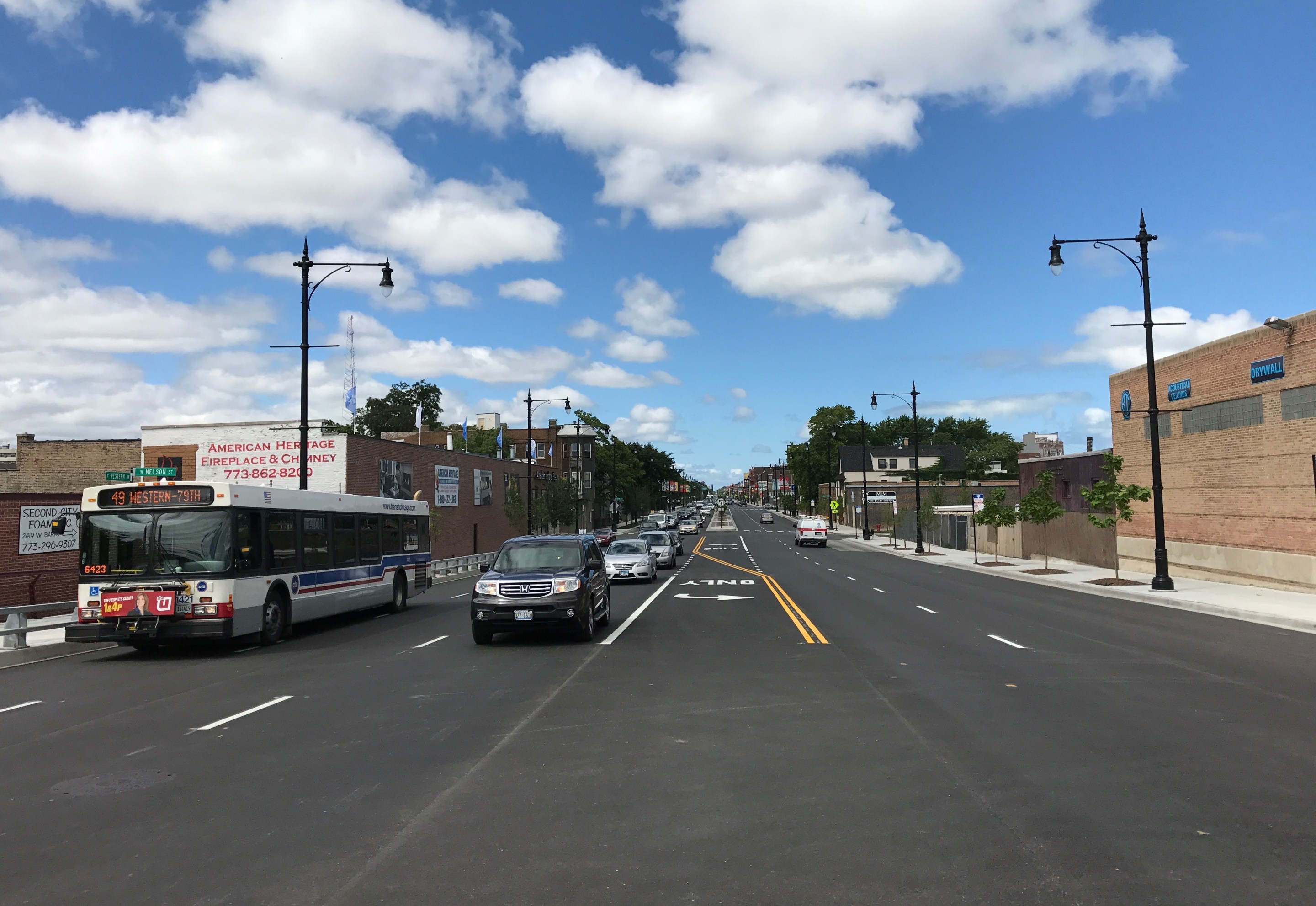The five-way intersection of Belmont, Western, and Clybourn, as well as the stretch of Western between the Chicago River and Lane Tech High, is friendlier to pedestrians and a lot less gloomy thanks to the just-completed project to remove the nearly 60-year-old Riverview flyover. However, the street makeover missed some opportunities to make the corridor safer and more accessible to all road users, maintaining the overwhelmingly car-centric nature of the corridor.
The flyover, which allowed vehicles on Western to pass over the Belmont/Clybourn junction without stopping, was built in 1960 in an effort to address street congestion associated with Riverview Park. The 74-acre theme park, once billed as the largest amusement park in the world, closed a mere seven years later, but the ugly concrete structure has reduced property values along Western for decades, and had deteriorated badly in recent years.
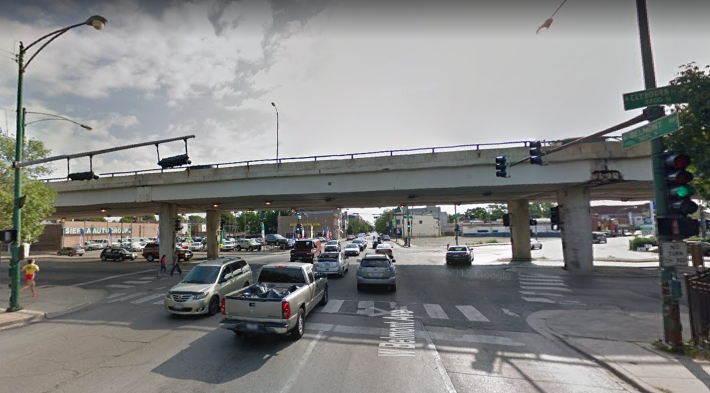
The $27.3 million Western corridor improvement project, funded through a mix of federal, state and tax-increment financing district funds, began in March 2016 and was completed a few weeks ahead of schedule. This afternoon Mayor Rahm Emanuel and Chicago Department of Transportation commissioner Rebekah Scheinfeld cut the ribbon on the street remix, which covered the 1.27 mile stretch of Western Ave. between Logan and Waveland. They heralded it as an improvement for safety and traffic flow.
A recent column by my Chicago Reader colleague Ben Joravsky razzed the mayor for bragging about Chicago’s relatively dependable transit system in a New York Times op-ed without giving any credit to CTA workers. Perhaps it’s no coincidence that Emanuel began his speech by thanking the workers for completing the project ahead of schedule and on budget.
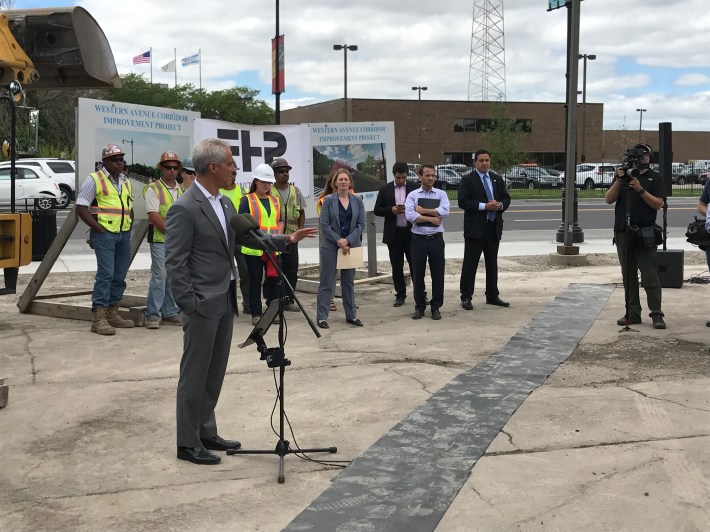
The mayor called the old flyover an “eyesore” and argued that it impeded economic development in the neighborhood. “This significantly improves the quality of life,” he said. “It makes a step for safer streets.” He added that, along with the reconfiguration of the nearby Fullerton/Elston/Damen intersection, “all the flow of traffic is going to be that much easier for everyone getting home from work or school.”
Motorists will probably be satisfied with the new layout of the corridor. The removal of the flyover was an opportunity to convert this stretch of Western into a human-scale boulevard, or at least put it in line with the street typical citywide layout of four travel lanes plus turn lanes. However, decision makers chose to maintain the six travel lanes that existed when the flyover was in place. While changing the street to an at-grade roadway makes the corridor more pleasant, the massive scale means it remains a fairly daunting barrier for pedestrians.

In fairness, pedestrian improvement make walking along and crossing Western safer and more convenient than it previously was. Refuge islands have been added at several intersections, sidewalks have been widened, and curb bumpouts, high-visibility crosswalks, and wheelchair ramps have been installed. Pedestrian countdown timers have been added at all intersections with stoplights, and new street trees and planter medians improve the aesthetics of the formerly dismal corridor.
“We don’t want people driving to get across the street, which some people said they were doing previously” due to the wide roadway and unsignalized intersections, Scheinfeld told me. “Pedestrian improvements along the corridor are vital to provide continuing improvements in livability for the institutions, residential users, and all the retail along Western.”
The city says the project also includes synchronized traffic signals designed to improve traffic flow for CTA buses and private vehicles. The stoplights also have the capacity to provide transit signal priority for buses.
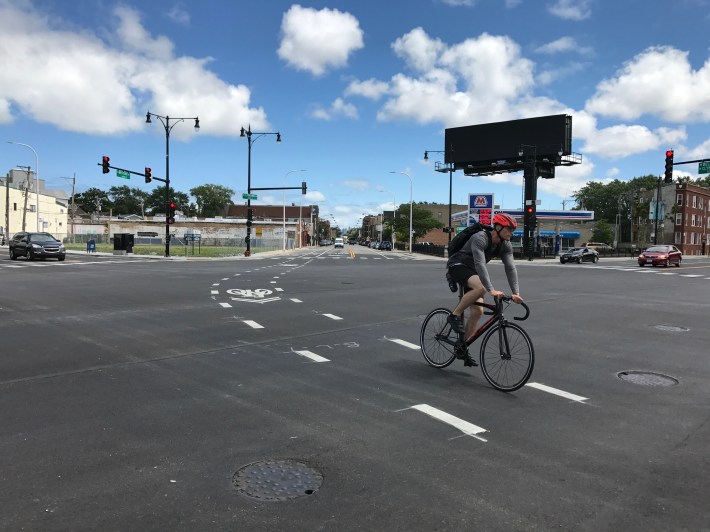
One area where the Belmont/Western/Clybourn makeover currently falls short is bike access. As a nod to cyclists, a dashed lane has been striped through the intersection to facilitate left turns from the northwest-bound Clybourn buffered bike lane to Belmont an another important biking street.
But while, as of early 2015, Belmont was slated to get a road diet with buffered lanes west of Western all the way to Kedzie, that project was later shelved. Not only are there still four travel lanes on Belmont west of Western, the east-west street balloons to six lanes on the west side of the intersection to make room for four through lanes plus left and right turn lanes for eastbound drivers. This represents a notable lapse in the city’s Complete Streets policy, especially since Belmont is designated as a bike-priority Crosstown Route in the city’s Streets for Cycling Plan 2020.
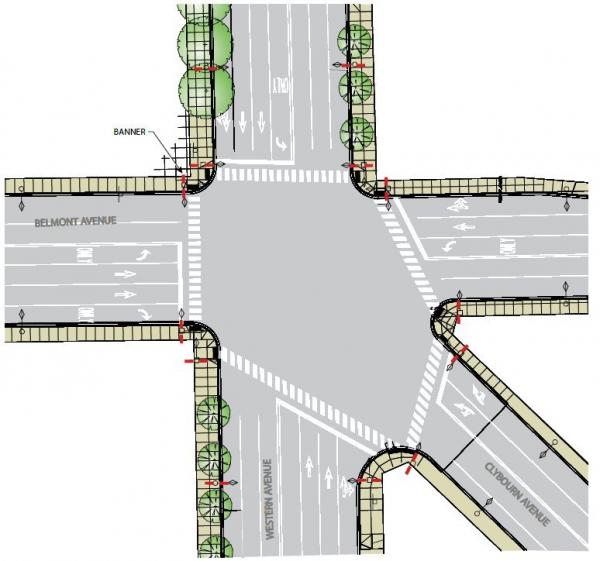
Scheinfeld told me that the possibility of bike lanes on Belmont is still on the table for the future. The bikes lanes and the Western corridor remix were two separate projects, she said, adding that the design planning for Western started long before the 2012 publication of the bike plan. “We didn’t want to slow down [the Western] project in terms of the overall mobility and safety improvements… Recognizing that there are still concerns from the bicycling community and general concerns about bicycling along the Belmont corridor, those [bike lane] designs are being reviewed by the aldermen and the CTA. [As of] today we still haven’t come up with a solution that balances all the demands of all the users appropriately on Belmont. It’s still to be resolved.”
While the modest improvements for pedestrians and transit users along the Western corridor are a positive development, hopefully the city will soon get moving on providing bike lanes on Belmont. In particular, getting cyclists safely through the still-massive Belmont/Western/Clybourn intersection is going to be a challenge.
